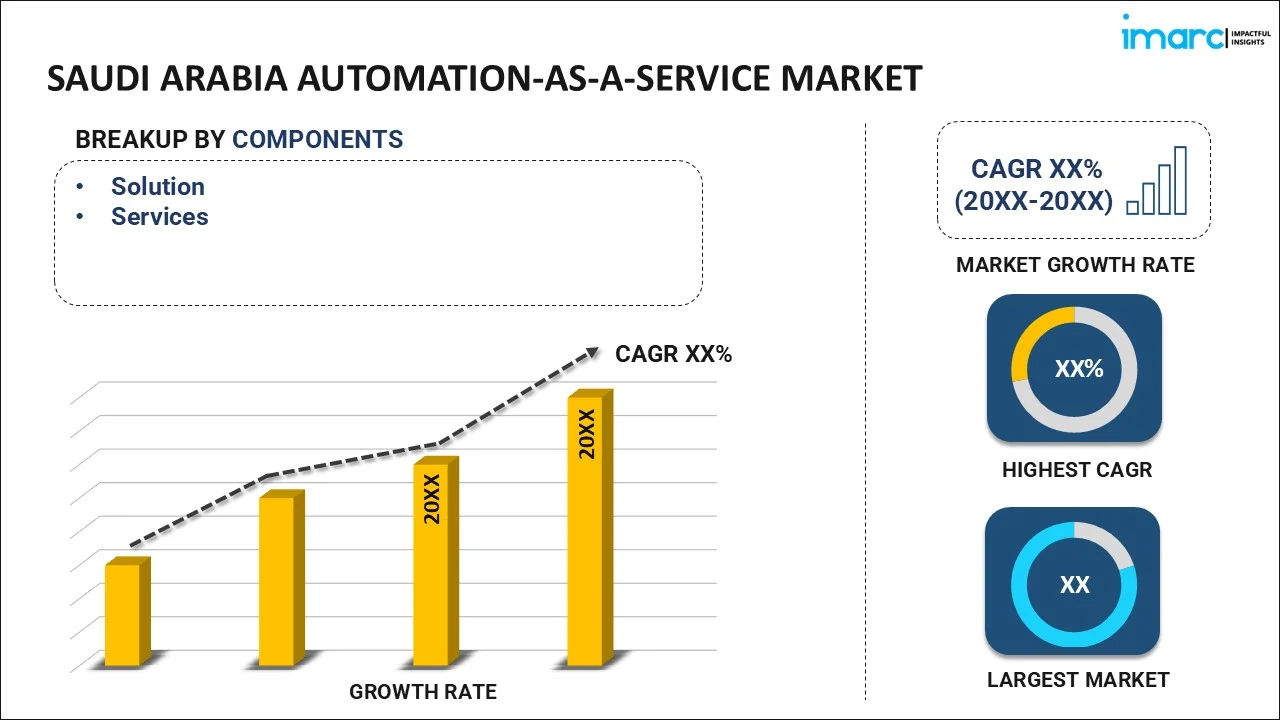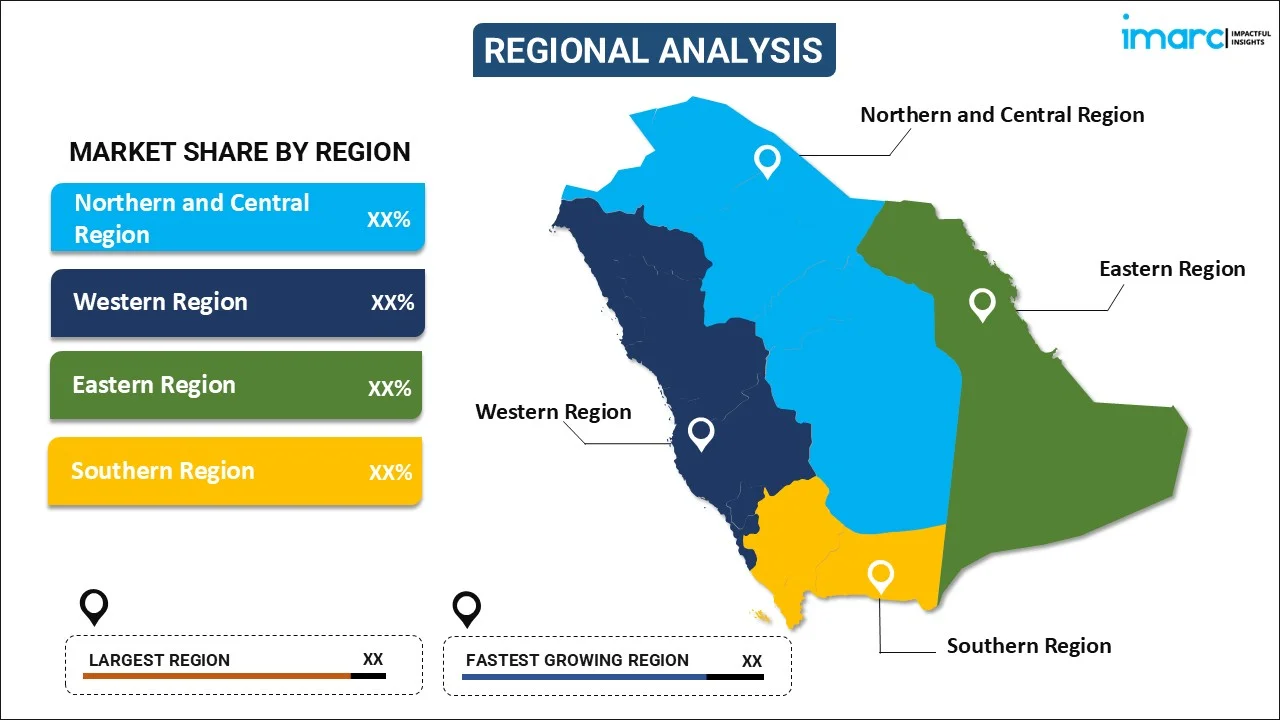
Saudi Arabia Automation-as-a-Service Market Report by Component (Solution, Services), Deployment Type (On-premise, Cloud-based), Business Function (Information Technology, Sales and Marketing, Operations, Finance, Human Resource, and Others), Enterprise Size (Large Enterprises, Small and Medium Enterprises), Vertical (BFSI, Telecom and IT, Retail and Consumer Goods, Healthcare and Life Sciences, Manufacturing, and Others), and Region 2025-2033
Saudi Arabia Automation-as-a-Service Market Overview:
The Saudi Arabia automation-as-a-service market size reached USD 94.09 Million in 2024. Looking forward, IMARC Group expects the market to reach USD 246.61 Million by 2033, exhibiting a growth rate (CAGR) of 10.70% during 2025-2033. The market is expanding due to strong digital transformation initiatives under Vision 2030. Additionally, growth is fueled by rising demand for cloud-based solutions, advanced IT infrastructure development, and increased automation in key industries such as manufacturing and healthcare.
|
Report Attribute
|
Key Statistics
|
|---|---|
|
Base Year
|
2024
|
|
Forecast Years
|
2025-2033
|
|
Historical Years
|
2019-2024
|
| Market Size in 2024 | USD 94.09 Million |
| Market Forecast in 2033 | USD 246.61 Million |
| Market Growth Rate 2025-2033 | 10.70% |
Saudi Arabia Automation-as-a-Service Market Trends:
Emphasis on Digital Transformation Through Vision 2030
Saudi Arabia's automation-as-a-service market is heavily influenced by the government's vision 2030 initiative, which focuses on economic diversification and advanced technological integration. For instance, according to International Trade Administration (ITA), artificial intelligence is a key area of focus, with spending in the sector projected to exceed USD 720 million in 2024 and reach USD 1.9 billion by 2027, reflecting a CAGR of 40%. Guided by the Saudi Data and AI Authority (SDAIA), this strategic emphasis aims to position the Kingdom as a global leader in AI by 2030. Additionally, public, and private sectors are increasingly deploying automation solutions to streamline processes, improve customer engagement, and foster innovation. The alignment of government policies and significant investments in IT infrastructure create a robust environment for automation providers. This trend showcases the nation's commitment to becoming a regional leader in technology and digital services, driving substantial market growth in the automation sector.
Increased Adoption of Cloud-Based Automation Solutions
The adoption of cloud-based automation solutions is surging in Saudi Arabia as businesses prioritize flexibility, scalability, and cost efficiency. For instance, in 2023, Google launched its newest cloud region in Saudi Arabia, making it one of 39 global regions. The cloud initiative is projected to contribute $109 billion to Saudi Arabia’s digital economy and create 148,600 jobs by 2030. This move aligns with Saudi Arabia's economic growth, which saw an 8.7% increase in GDP last year. Enterprises are transitioning from traditional IT frameworks to cloud-native platforms to facilitate automated workflows and optimize operations. The demand for remote work and digital collaboration tools further accelerates this shift. Additionally, the robust cloud infrastructure in Saudi Arabia, supported by global and local technology firms, has enabled seamless integration of automation-as-a-service solutions. This scalable model attracts large enterprises and SMEs alike, driving widespread adoption and market growth.
Expansion of Automation in Manufacturing and Healthcare
Automation in manufacturing and healthcare is emerging as a significant trend within Saudi Arabia's automation-as-a-service market. In manufacturing, automation technologies are being adopted to streamline production, enhance precision, and improve supply chain management. For instance, in 2024, Alat, a PIF company, formed a strategic partnership with SoftBank Group to establish an advanced industrial automation business in Saudi Arabia. With a USD 150 million joint investment, they envision building a fully automated manufacturing hub in Riyadh to produce cutting-edge industrial robots, contributing USD 1 billion to Saudi GDP by 2025 while promoting sustainable, carbon-neutral manufacturing. In healthcare, automation is optimizing patient care, data management, and administrative tasks, reducing manual errors and improving productivity. These developments align with Saudi Arabia’s broader drive to modernize key sectors and improve operational efficiency, highlighting growing market demand for specialized automation solutions.
Saudi Arabia Automation-as-a-Service Market News:
- In 2024, Dematic, a leading global automation technology provider, announced the opening of its new office in Riyadh, Saudi Arabia, enhancing its regional presence. This strategic expansion aligns with Vision 2030, supporting local industries with advanced automation solutions such as AS/RSs and GTP systems. Dematic aims to boost productivity and efficiency across key sectors, including retail, e-commerce, and healthcare.
Saudi Arabia Automation-as-a-Service Market Segmentation:
IMARC Group provides an analysis of the key trends in each segment of the market, along with forecasts at the regional and country levels for 2025-2033. Our report has categorized the market based on component, deployment type, business function, enterprise size, and vertical.
Component Insights:

- Solution
- Services
The report has provided a detailed breakup and analysis of the market based on the component. This includes solution and services.
Deployment Type Insights:
- On-premise
- Cloud-based
A detailed breakup and analysis of the market based on the deployment type have also been provided in the report. This includes on-premise and cloud-based.
Business Function Insights:
- Information Technology
- Sales and Marketing
- Operations
- Finance
- Human Resource
- Others
The report has provided a detailed breakup and analysis of the market based on the business function. This includes information technology, sales and marketing, operations, finance, human resource, and others.
Enterprise Size Insights:
- Large Enterprises
- Small and Medium Enterprises
A detailed breakup and analysis of the market based on the enterprise size have also been provided in the report. This includes large enterprises and small and medium enterprises.
Vertical Insights:
- BFSI
- Telecom and IT
- Retail and Consumer Goods
- Healthcare and Life Sciences
- Manufacturing
- Others
The report has provided a detailed breakup and analysis of the market based on the vertical. This includes BFSI, telecom and IT, retail and consumer goods, healthcare and life sciences, manufacturing, and others.
Regional Insights:

- Northern and Central Region
- Western Region
- Eastern Region
- Southern Region
The report has also provided a comprehensive analysis of all the major regional markets, which include Northern and Central Region, Western Region, Eastern Region, and Southern Region.
Competitive Landscape:
The market research report has also provided a comprehensive analysis of the competitive landscape. Competitive analysis such as market structure, key player positioning, top winning strategies, competitive dashboard, and company evaluation quadrant has been covered in the report. Also, detailed profiles of all major companies have been provided.
Saudi Arabia Automation-as-a-Service Market Report Coverage:
| Report Features | Details |
|---|---|
| Base Year of the Analysis | 2024 |
| Historical Period | 2019-2024 |
| Forecast Period | 2025-2033 |
| Units | USD Million |
| Scope of the Report | Exploration of Historical Trends and Market Outlook, Industry Catalysts and Challenges, Segment-Wise Historical and Future Market Assessment:
|
| Components Covered | Solution, Services |
| Deployment Types Covered | On-premise, Cloud-based |
| Business Functions Covered | Information Technology, Sales and Marketing, Operations, Finance, Human Resource, Others |
| Enterprise Sizes Covered | Large Enterprises, Small and Medium Enterprises |
| Verticals Covered | BFSI, Telecom and IT, Retail and Consumer Goods, Healthcare and Life Sciences, Manufacturing, Others |
| Regions Covered | Northern and Central Region, Western Region, Eastern Region, Southern Region |
| Customization Scope | 10% Free Customization |
| Post-Sale Analyst Support | 10-12 Weeks |
| Delivery Format | PDF and Excel through Email (We can also provide the editable version of the report in PPT/Word format on special request) |
Key Questions Answered in This Report:
- How has the Saudi Arabia automation-as-a-service market performed so far and how will it perform in the coming years?
- What has been the impact of COVID-19 on the Saudi Arabia automation-as-a-service market?
- What is the breakup of the Saudi Arabia automation-as-a-service market on the basis of component?
- What is the breakup of the Saudi Arabia automation-as-a-service market on the basis of deployment type?
- What is the breakup of the Saudi Arabia automation-as-a-service market on the basis of business function?
- What is the breakup of the Saudi Arabia automation-as-a-service market on the basis of enterprise size?
- What is the breakup of the Saudi Arabia automation-as-a-service market on the basis of vertical?
- What are the various stages in the value chain of the Saudi Arabia automation-as-a-service market?
- What are the key driving factors and challenges in the Saudi Arabia automation-as-a-service?
- What is the structure of the Saudi Arabia automation-as-a-service market and who are the key players?
- What is the degree of competition in the Saudi Arabia automation-as-a-service market?
Key Benefits for Stakeholders:
- IMARC’s industry report offers a comprehensive quantitative analysis of various market segments, historical and current market trends, market forecasts, and dynamics of the Saudi Arabia automation-as-a-service market from 2019-2033.
- The research report provides the latest information on the market drivers, challenges, and opportunities in the Saudi Arabia automation-as-a-service market.
- Porter's five forces analysis assist stakeholders in assessing the impact of new entrants, competitive rivalry, supplier power, buyer power, and the threat of substitution. It helps stakeholders to analyze the level of competition within the Saudi Arabia automation-as-a-service industry and its attractiveness.
- Competitive landscape allows stakeholders to understand their competitive environment and provides an insight into the current positions of key players in the market.
Need more help?
- Speak to our experienced analysts for insights on the current market scenarios.
- Include additional segments and countries to customize the report as per your requirement.
- Gain an unparalleled competitive advantage in your domain by understanding how to utilize the report and positively impacting your operations and revenue.
- For further assistance, please connect with our analysts.
 Inquire Before Buying
Inquire Before Buying
 Speak to an Analyst
Speak to an Analyst
 Request Brochure
Request Brochure
 Request Customization
Request Customization




.webp)




.webp)












